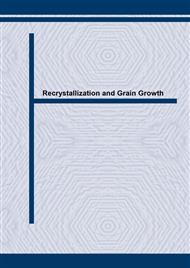p.813
p.819
p.825
p.835
p.843
p.853
p.863
p.869
p.875
Abnormal Grain Coarsening and Its Possible Relationship with Particle Limited Normal Grain Coarsening
Abstract:
The prior literature on abnormal grain coarsening (AGC) at low volume fractions (f) of stable second phase particles in high purity Al alloys is reviewed and reanalyzed in the light of developments in modeling particle inhibition of grain boundary migration. With the usual assumptions (i) of incoherent particles that retain their shape on contact with the grain boundaries and (ii) that all the grain boundaries are equally mobile, it appears impossible to account for process of AGC. Normal grain coarsening (NGC) is shown to be less inhibited by the particles than is AGC. This idea is explored using a new but simple model of particle inhibition by curvature removal. The curvature of the smallest grains is always larger than that of the larger grains. Two possible hypotheses to overcome this difficulty are proposed: First the possible change of shape of particles on slowly moving grain boundaries, of grains with near 14 neighbors should, after a small increment of NGC, promote AGC at low values of the volume fraction f. The second hypothesis involves the observed high density of immobile, low angle grain boundaries (LAGBs) found in recent experiments on high purity Al-Fe-Si alloys cast with very coarse grain sizes. These alloys undergo rapid AGC even at higher values of f (> 0.01). These LAGBs are expected to inhibit the shrinkage of many of the small grains, whose loss is the fundamental mechanism of NGC.
Info:
Periodical:
Pages:
843-852
Citation:
Online since:
October 2004
Keywords:
Price:
Сopyright:
© 2004 Trans Tech Publications Ltd. All Rights Reserved
Share:
Citation:


